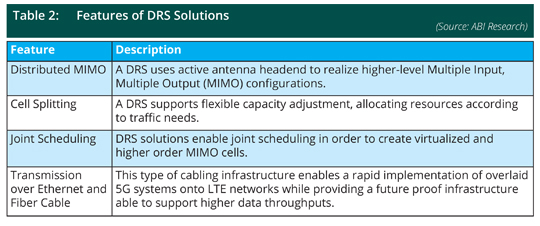State of the In-Building Wireless Market in the 5G Era
|
NEWS
|
In the 5G era, traditional Distributed Antenna Systems (DASs) are facing several limitations to incorporating 5G and increasing overall system capacity. These limitations are mainly associated with two factors: 1) the new frequency bands in which 5G typically operates and 2) the major infrastructure work needed to increase the capacity of the system. The higher frequencies in which 5G typically operates (C-band and mmWave) present higher power losses in the feeder, which will ultimately result in higher deployment costs (due to additional infrastructure required), reduced coverage footprint, and poor performance. To augment capacity, extra feeder cables and passive/active components are required, along with reconstructive engineering to meet 5G requirements.
In-building wireless systems have transitioned from the analog domain that uses co-axial feeder cables, i.e., from DAS to the digital domain, where analog cables are replaced with fiber and/or Ethernet cables. These systems are now referred to as active DAS and Distributed Radio Systems (DRSs), and they introduce a major efficiency and capability boost compared with previous DASs, including higher flexibility for capacity expansion, higher data throughputs, and lower latency.
Among the other benefits, DRSs introduce the following advancements compared to DASs.

Several companies are now pursuing the next generation of in-building wireless systems, aiming to upgrade capacity and future capabilities of existing systems. The following list illustrates a few examples of these technologies:
- The Huawei LampSite Digital Indoor System (DIS) offers distributed massive MIMO, as discussed in more detail below.
- Ericsson’s Radio Stripes offers cell-free operation for in-building wireless systems, as discussed in more detail in ABI Insight “A Glimpse into the Future of Massive MIMO.”
- Other smaller companies, including Artemis with its pCell product line, have developed similar concepts, but have not yet commercialized them on a large scale.
Of all of these initiatives, Huawei appears to have commercialized the distributed massive MIMO option of its LampSite product line. The following section outlines the key benefits of this solution.
Distributed Massive MIMO
|
IMPACT
|
The tight coordination between the different distributed radio units allows for what is referred to as distributed massive MIMO, where multiple logical antennas act as a large system with the ability to track users. This advanced feature mitigates interference that is typically a debilitating factor when cell splitting is used in-building wireless systems as a technique to increase capacity. Distributed massive MIMO is, in fact, an area that is seeing an increasing amount of Research and Development (R&D) with academic studies,[1], [2] illustrating the performance improvement compared with simple 4T4R systems.
The benefits of distributed massive MIMO are multiple, but in terms of user experience, the most important are the following:
- In areas that are covered by more than one radio unit (Pico Remote Radio Unit (pRRU)), the capabilities of these radios are combined to offer a better link, higher modulation schemes, and a much faster connection.
- At the edge of the system coverage, beamforming is increases capacity and improves perceived end-user speeds.
- The system can employ multi-beam spatial multiplexing to isolate users from each other and increase the overall system capacity in both the uplink and downlink.
Huawei claims these advantages are achieved through software upgrades in the baseband unit for LampSite systems, which is arguably an easy potential upgrade for existing systems. The scheduler of the system can certainly be located and easily upgraded with additional functionality.
[1] Distributed massive MIMO: algorithms, architectures and concept systems
[2] Scaling up Distributed Massive MIMO: Why and How
Conclusions
|
RECOMMENDATIONS
|
The introduction of distributed massive MIMO is an important milestone for in-building wireless due to the vital capacity upgrade the new technology introduces. In the consumer domain, distributed massive MIMO can introduce a better end-user experience, especially in crowded areas, such as stadiums, airports, train stations, shopping malls, and subways. These environments are the key focus for several operators in developed markets. In the enterprise domain, the new technology enables high uplink and downlink capacity, and is a highly resilient system that can address a variety of enterprise use cases in the manufacturing, logistics, transport, and media sectors. Distributed massive MIMO is indeed the next evolution of digital in-building wireless systems and Huawei is the first to commercialize this new technology.

